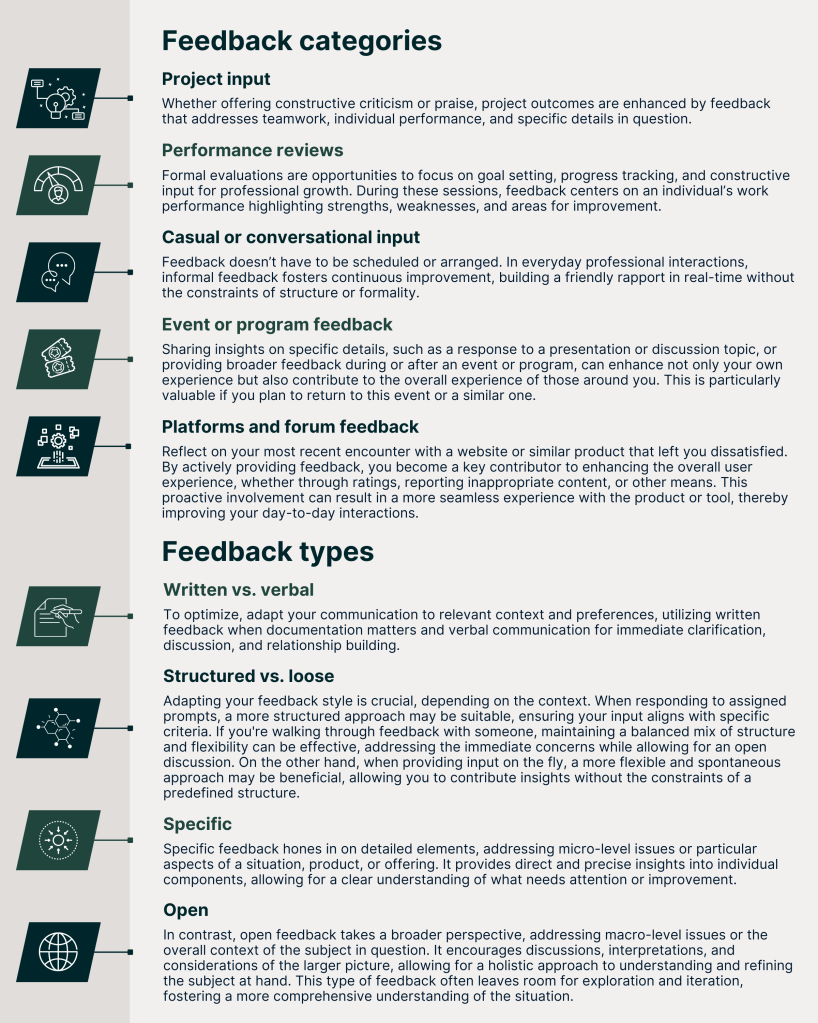Great ideas often aren’t born that way. They typically require lots of care, input, and iteration. And, even when you weren’t the original initiator of a good idea, your ability to provide feedback is what could make a real impact, transforming it into something great.
If it isn’t obvious, we believe that feedback is a differentiator. And, if you harness the ability to give and receive it professionally, it could be your differentiator.
As we’ve previously defined it, feedback is a form of communication that has the potential to offer valuable insights into various aspects of our performance, behaviors, and actions.
We believe that embracing feedback is pivotal. However we also believe that your ability to effectively offer feedback is a skill that could set you apart in your career — especially in the realms of professional development and relationship building.
In this article, we will provide an overview of key considerations for giving feedback, discuss the importance of each, and provide insights on where you can practice this art in your own career.
Feedback dynamics: Navigating opportunities across professional relationships
Over the course of your career, opportunities to provide feedback may present themselves. And in many cases, your colleagues, mentors, and peers may directly request it. Let’s explore a few distinct roles or scenarios where the exchange of feedback is particularly useful.
- As a mentor, you have the opportunity to provide guidance and support to less experienced individuals as they navigate their own professional journeys. This feedback may entail offering insights or anecdotes from your career or providing constructive feedback based on your own experiences.
- As a mentee, depending on the nature of your relationship, offering feedback on communication and mentorship styles has the potential to strengthen your bond and promote a collaborative, two-way learning experience.
- Career professionals play an important role in offering unbiased feedback to help their clients navigate the workforce, discover new paths, or communicate their worth to employers. This feedback can be verbal or more tangible — think resume reviews!
- As a coaching recipient, you might have an opportunity to course-correct or optimize your coaching experience by offering feedback to them directly. Depending on the nature of your relationship, the way you offer said feedback, and the way the feedback is received, this act could help you to better tailor your coaching experience to meet your own needs, communication style, and journey.
Peer interactions offer a chance to build trust and understanding, and foster continuous improvement through constructive feedback. Collaboratively exchanging feedback with colleagues at a similar professional level contributes to a culture of mutual support.
- Leadership roles often entail providing feedback, a skill crucial to success. Whether through formal avenues like performance reviews or informal conversations, adapting feedback to diverse recipients and scenarios is key.
- In turn, direct reports might have the opportunity to provide feedback to leaders through planned mechanisms like surveys or quarterly meetings and casual conversations alike — assuming you’ve built a rapport with that leader. By providing feedback upward, you have the opportunity to contribute to the improvement of day-to-day operations and your 1:1 relationship.
Refining your feedback approach: Considerations to make
Regardless of the situation, cultivating awareness of the nuances that exist in the delivery of feedback can elevate your approach — a gesture your recipients will thank you for.
Exploring feedback categories and types
Let’s delve into various types of feedback, each offering distinct considerations to enhance your effectiveness:

Navigating nuance: Approaches to consider when offering feedback
In order to ensure that your feedback is effective, be sure to gauge receptiveness first. Just because you have input doesn’t mean that it’s appropriate to share. After all, we support you in the pursuit of non-awkward exchanges!
Prior to offering feedback, especially in cases of unsolicited feedback, we recommend seeking permission. Once you feel comfortable proceeding, consider the recipient’s individual characteristics and nuances. Recognizing their unique strengths, challenges, and learning styles enables you to deliver feedback that is meaningful and aligns with their specific goals.
Timing is crucial in this process! Avoid dropping feedback at inappropriate moments or when the atmosphere isn’t right. Respecting their boundaries and the surrounding context enhances the receptiveness and, ultimately, your relationship with the recipient.
Lastly, anticipate the possibility that your feedback may not always be well-received or could be subject to misinterpretation. In those instances, keep an open mind and encourage further discussion, seeking clarification on points of contention and adjusting your approach as needed. Your ultimate goal? Cultivating a harmonious process of two-way professional growth and development through constructive feedback.
Here are a few considerations to make, approaches to adopt, and pieces of anecdotal evidence to explore:
Constructive vs. critical approach: Striking a balance between positive and constructive feedback while avoiding criticism that lacks actionable insights is key. A constructive approach centers on improvement and providing solutions and guidance, all while fostering a positive and growth-oriented mindset for professional development. This approach motivates individuals by acknowledging their successes and guiding them toward continuous enhancement. In contrast, a critical approach merely points out what isn’t working without offering solutions or opportunities for improvement.
Consider this: You’re part of a project team working on a complex marketing campaign. The team has put in long hours, and everyone is excited to see the visuals that were developed by part of the group. As the project concludes, you are solicited to provide unbiased feedback on those visuals. However, you decide that the team has already worked hard enough, and you would rather give a positive response than offer criticism of any kind. In a brief meeting, you mention that the campaign looks amazing without offering any ideas for improvement. By avoiding conflict and refusing to provide the team with accurate or constructive feedback on the visuals, you keep the team from optimizing the campaign and even risk a future lack of trust.
Tone: The tone of your feedback significantly influences its reception. Depending on the recipient, maintaining a positive and constructive tone typically fosters a collaborative atmosphere, encouraging individuals to be receptive to improvement suggestions. A considerate tone also helps build trust and strengthens professional relationships. Always make sure to ask your recipient what they’d prefer in terms of directness or gentleness: that way, you can tailor feedback to their communication style and needs.
Consider this: Imagine receiving feedback that really compliments your accomplishments in a role and gives you clear, positive reinforcement on your career trajectory, all delivered with a negative and harsh tone. This not only makes you question the genuineness of the feedback but also might cause more confusion than you had when you asked for that feedback in the first place.
Timing: Timing is everything when delivering feedback. Providing feedback promptly ensures that it remains relevant and actionable. Thoughtfully choosing the right moment considers the individual’s emotional state, creating an environment conducive to constructive dialogue.
Consider this: Picture a scenario where you’ve just completed a challenging task. After sending the completed task to a colleague for review, they promptly provide feedback that acknowledges your effort and provides constructive input. This allows you to immediately apply the insights while the task is fresh in your mind, therefore maximizing the impact of the feedback, not to mention meeting your deadlines!
Relevance and clarity: Feedback must be relevant and clear to have a meaningful impact. Ensuring that feedback directly addresses the situation or task at hand, coupled with clear communication, enhances its effectiveness. This helps individuals understand the specific areas for improvement and the actions needed for growth.
Consider this: A colleague asks for feedback on a graphic design project, and you simply tell them that something is off without indicating what that might be. That colleague might now make unnecessary iterations to the piece in the hopes that they’ve solved an ambiguous problem.
Employing empathy: Infusing empathy into feedback is essential for building trust and understanding. Recognizing the emotional impact of feedback and showing understanding toward an individual’s challenges fosters a supportive environment. Empathy enhances the effectiveness of feedback by addressing both professional and personal aspects.
Consider this: Imagine that you were tasked with a daunting project during a time of personal hardship. You solicit feedback from a colleague. They give you specific feedback on the project that not only highlights areas for improvement but also acknowledges the effort you put into a project during such a challenging time and even offers support in the next steps. By acknowledging the challenges you faced, this feedback provider holds space for your human experience while also offering solutions for your workload and the specifics of the project itself.
Audience-specific approach: Tailoring feedback to the audience is paramount. Whether providing feedback to a team, a subordinate, or a peer, understanding their unique roles, responsibilities, information-receiving preferences, and perspectives ensures that the feedback is relevant and resonates with their specific context.
Consider this: You provided feedback to a team of collaborators using technical jargon that only experts specific to your role understand. After the meeting, the team of collaborators is left feeling inadequate and confused, which causes them to misinterpret your message. Always make sure to adapt your language to suit your audience to make sure your input is both digestible and actionable.
Goal or development orientation: Feedback should be aligned with individual goals or development plans. Communicating how the feedback contributes to professional growth or goal attainment provides individuals with a clear sense of purpose and direction.
Consider this: A colleague gives you feedback on a prototype that not only highlights areas for design improvement but also connects those improvements to your long-term career goals, acknowledging your interest in certain fields or disciplines. By drawing that connection, the feedback provider makes the feedback significantly more meaningful and encourages you to take proactive steps toward development.
Confidentiality and trust: Upholding confidentiality builds trust in the feedback process. Ensuring that sensitive information is handled with discretion reinforces trust between the giver and receiver of feedback, creating an environment conducive to open communication.
Consider this: Imagine receiving feedback about a personal challenge you’ve shared in confidence, and your confidant respects your privacy by not disclosing any details about this exchange to others. In keeping that promise of confidentiality, the feedback provider builds trust and strengthens that relationship.
Ongoing feedback: Follow-up discussions are integral to the feedback process. Scheduled follow-ups provide an opportunity to track progress, address any ongoing challenges, and reinforce positive changes. Consistent follow-up demonstrates a commitment to continuous improvement.
Consider this: A colleague who previously provided you with feedback on your communication style followed up to acknowledge the positive changes you’ve made. By continuing the cycle of feedback through positive reinforcement, they’ve given you clarity on how to refine that skillset moving forward, proved their investment in you, and encouraged your quest for continuous improvement.
Awareness: Cultivating awareness of cultural nuances and contextual factors is pivotal in delivering effective feedback. Recognizing and respecting diverse cultural perspectives ensures that feedback is received in a culturally sensitive manner. Being attuned to individual differences and understanding the broader context in which feedback is given contributes to a more inclusive and considerate approach. This awareness fosters an environment where feedback is constructive, culturally respectful, and supportive of diverse backgrounds and experiences.
Consider this: An international colleague wraps up a project and presents it to your team. You immediately offer them unsolicited feedback, which is very direct and blunt. While this delivery might be something that you are used to, it might come across differently to them due to cultural norms and differences. Sure, that doesn’t make your approach wrong, but it might be less effective for that recipient.
Conclusion
In the realm of professional development, honing the skill of delivering feedback can serve as a catalyst for continual growth, enhancing not only your proficiency in communication but also fortifying your professional relationships.
As you navigate the diverse avenues for providing feedback — be it in project evaluations or informal discussions — a thoughtful and purposeful approach makes all the difference. With that in mind, to enhance your feedback skills, we encourage you to read and absorb the anecdotal evidence used in this article and actively apply lessons from it to your approach.
To tailor your feedback appropriately, ask clarifying questions and adapt communication methods to individual preferences. Consider incorporating real-world scenarios and personal narratives into your feedback dialogue to further illustrate the principles discussed here.
Bear in mind that the process of providing feedback is dynamic and ever-evolving. While aiming for a balance between positive affirmation and constructive guidance, recognize the importance of tailoring your feedback with empathy and cultural awareness to cultivate an inclusive and supportive environment.
Your feedback has the potential not only to positively impact the professional livelihoods of those around you but also to elevate your own professional environment and skillset. Embrace your opportunity to make a difference through thoughtful input and, when in doubt, reflect on how you’d like to receive feedback yourself. After all, the journey of growth is a collective one, and effective feedback plays a pivotal role in shaping the future of work.










